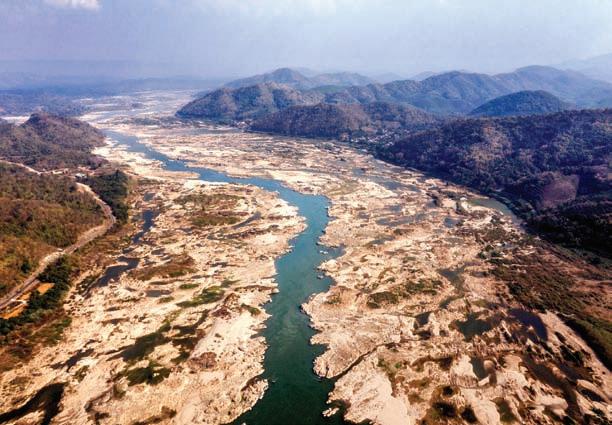
54 minute read
Raising of FDI Cap in Defence Entails Complications
Indian Army’s MBT Arjun in action
(i) Advantage of Monopoly.
Advertisement
OFB’s advantage of being a monopolist supplier has resulted in minimal innovation and technology development leading to resulting in low productivity as evidenced in the low value of Issue (VOI).
Zero penalty for delayed delivery and lack of a structured, dynamic feedback mechanism have only added to the Services’ frustration and woes. VOI for the past five years is as below: (ii) Poor quality of weapons:
Most quoted instances being the INSAS Rifle and cases of qualitative deficiencies in ammunition. (iii) High cost of products: OFs being monopolistic suppliers, ipso facto, the pricing of their products is not based on market dynamics. A high proportion of budgetary allocations to OFs go towards salaries and wages to their approximately 85,000 employees. (iv) Lack of user interface: While there is a Service representation through Principal Staff Officer level official at the OFB Board level, there is minimum direct interface between the User (Line Dte in the Services
HQ) and the OFs through the product development or manufacturing stages. (v)‘Protected’ employment guarantee of a government job: OFB employees enjoy the
‘safe and secure’ status of being government employees. They are unwilling to transit to an environment of ‘competitive production’. (Reports of protest by employees post the announcement to corporatisation the OFB, and efforts to assuage them are self-speaking).
Year Target (in Rs crores)
Value of Issue (in Rs crores) 2014-15 RE 12120 11391 2015–16 RE 13552 13111 2016–17 RE 15393 14825 2017–18 RE 14115 14127 2018–19 MA 13249 12801 % Achievement
94% 96.7% 96.3% 100.1% 96.6%
EXPECTED FRUITS OF OFB CORPORATISATION
Developing a Viable Ecosystem: As ‘Systems Integrators’, OFs directly manufacture critical components / sub-assemblies, sourcing non-critical items from private vendors through annual or ‘as required’ competitive bidding. The uncertainty of assured supply orders leaves little incentive for vendors to invest into product development and quality enhancement. OFB would now be enabled to draw up long term supply arrangements with vendors thereby creating an ecosystem primitive to efficiency and high quality.
Joint Ventures with Private Sector: OFB would be enabled, where required, to associate private industry into the production process exposing OF personnel to imbibe best practices of private sector performance.
Fiscal Autonomy: OFB would be unencumbered from limitations of budget allocations and can
raise funds for expansion and modernisation projects.
Empowering Factory Management: Contrary to apprehensions, the OF management would be better endowed with requisite discretionary powers to address shop floor issues and production delays.
Market Development and Exports: A corporatised OFB with facility to export its products to friendly foreign countries would provide leverage to form strategic alliances.
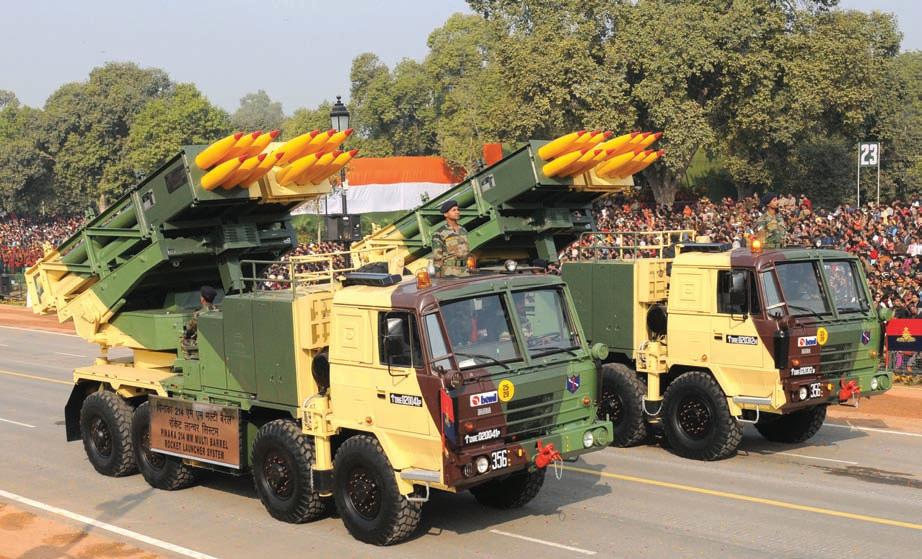
CONCLUSION
While OFB corporatisation is pragmatic and merits applause, there is need to also applaud its dedicated management and personnel who have assiduously worked with commitment and deep sense of ownership. That their full potential could not be exploited to national good is more due to systemic constraints than any shortcomings on their side. Their retention and upskilling is imperative. In the enthusiasm of reform, a precious baby with honed skills should not inadvertently be thrown out with the bath water.
OFB products strengthen
OFB Pinaka rocket launcher (File photo)
OFB’S ADVANTAGE OF BEING A MONOPOLIST SUPPLIER HAS RESULTED IN MINIMAL INNOVATION AND TECHNOLOGY DEVELOPMENT LEADING TO RESULT IN LOW PRODUCTIVITY AS EVIDENCED IN THE LOW VALUE OF ISSUE (VOI). NOT ONLY THIS, ZERO PENALTY FOR DELAYED DELIVERY AND LACK OF A STRUCTURED, DYNAMIC FEEDBACK MECHANISM HAVE ONLY ADDED TO THE SERVICES’ FRUSTRATION AND WOES
Indian Army artillery gun built by OFB
the most vital sinews of the nation’s security apparatus. Government’s interest in OFB matters will therefore be abiding, and rightfully so. There is a need to ensure that functional and oversight mechanisms are not so overbearing as to revert OFB to a Department with a ‘corporate’ avatar. Likewise, there is need to infuse some ‘real’ dynamism into R&D, innovation and product improvement. The challenge lies in achieving that balance.
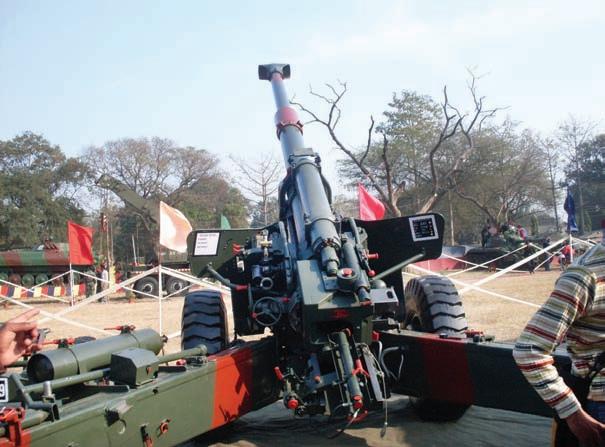
–The writer is a Senior Fellow at the Centre for Joint Warfare Studies (CENJOWS).
CANDID CONVERSATION ‘AFTER DELIVERING EVERYTHING FROM OUR SIDE WE ARE WAITING FOR COMMERCIAL NEGOTIATIONS TO CONTINUE ON KA-226T’ A
ndrey Boginsky, being in mid-40s, belongs to the new generation of post-Soviet industry executives. After getting a degree in financial management he worked in several private banks and did a post-graduate course in Economics from Foreign Ministry’s Diplomatic Academy. He later worked as Deputy Trade and Industry Minister, in-charge of the aviation industry. In 2017 he was appointed CEO of Russian Helicopters JSC, part of defence industry conglomerate Rostec.
In a candid conversation with Vinay Shukla, Consulting Editor, Raksha Anirveda, the Russian Helicopters CEO threw light on why India-Russia deal on Ka-226T utility helicopters couldn’t yet taken off besides discussing the progress status on 10 Ka-31 choppers for Indian Navy. Edited excerpts:
The big ticket order for Ka226T utility helicopters hasn’t taken off yet. What are the reasons that have stalled it and when do you expect that the issues will get resolved to get started? Any progress made during Defence Minister Rajnath Singh’s Moscow talks in June and September?
Nothing has moved. This is what we have done for our part: we have been running a joint venture in India for three years now between Russian Helicopters, Hindustan Aeronautics Ltd (HAL) and Rosoboronexport. We are still financingthisenterprise,butsadly we are not seeing concrete decisions from our Indian colleagues to proceed with the negotiations. I think we have done everything possible for our part.
Russia and India concluded an intergovernmental agreement for this in 2015. The Make in India program entails certain commitments considering technology transfer and
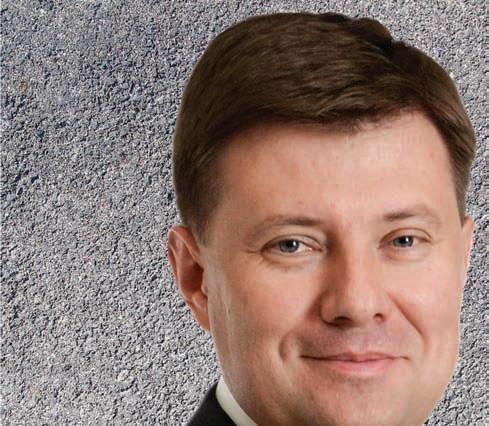

localization. Technology transfer has been confirmed and Indian partners have done lots of work in this topic. We reviewed several companies and selected the ones most suitable from our position andasconfirmedbytheIndianside. We concluded a memorandum of understanding (MOU) with these companies. Over several rounds of negotiations, we explained the localization procedure to our Indian colleagues from HAL and the Ministry of Defence (MoD), defined necessary financial resources and required deadlines, pointed out how we need to proceed. We have delivered everything needed from our side to the project. So now, we are just waiting for the commercial negotiations to continue.
The Government of India has banned import of 101 defence items including equipment and platforms and recently announced stimulus package under ‘Atmanirbhar Bharat’. Do you think these initiatives are going to impact the Russian defence suppliers?
It is hard to discuss the prospects of the ‘Atmanirbhar Bharat’, second part of the ‘Make in India’ program, as we are yet to experience the benefits of the first one, although we have already invested a lot of money. What I mean is that Make in India principle “invest, produce and we’ll buy from you” is not working for our company at this moment, as no one has bought anything from us. We have already made serious investments, for example, in Ulan-Ude (Helicopter Plant) we specifically invested in assembly lines for fulfilling Indian orders, made major changes to the helicopter itself in order to meet the customer’s requirements, increased its capacities, for our part we have done a lot.
We found Indian partners figuredoutwiththem,whichare already producing components in Republic of India, we could already have begun producing new Ka-226Ts.
Despite this delay, we hope that our partners have a firm intention to implement this project. Therefore, before moving on to the second part of the Make in India – Atmanirbhar Bharat, let’s see how the first one goes. Anyway we will not write off these investments as losses, considering that there is demand for the assembly of helicopters in other countries, so we want to move forward. We will naturally act based on commercial considerations and return the investments in one form or another.

Don’t you blame your potential rivals for the delay of Ka-226T project after
WE HAVE BEEN RUNNING A JOINT VENTURE IN INDIA FOR THREE YEARS NOW BETWEEN RUSSIAN HELICOPTERS, HAL AND ROSOBORONEXPORT. WE ARE STILL FINANCING THIS ENTERPRISE, BUT SADLY WE ARE NOT SEEING CONCRETE DECISIONS FROM OUR INDIAN COLLEAGUES TO PROCEED WITH THE NEGOTIATIONS
you proposed to combine Indian Navy’s requirement of 100 utility helicopters with the 200 utility helicopters to be produced by your JV with HAL?
I don’t see a point for speculating about the reasons for these delays from the business side of things. Of course we need to do our job. And since we can do it efficiently, it is disappointing to see the project delayed, as we are a commercial organization and cannot drag out the process indefinitely. Our shareholders keep asking whether they will receive their money or not. Our French colleagues from Safran

Ka-52M combat helicopter which madeitsmaidenflightinAugust. The helicopter manufacturer had started the experimental design work on the Ka-52’s upgrade began last year, taking into account its combat deployment. The Ka-52M’s missile armament has been standardized with the armament of another latest Mi-28NM helicopter, which has made it possible to considerably increase the range of striking targets. (According to the Trade and Industry Ministry statement issued after maiden flight, the new Ka-52M helicopter features upgraded longer-range optoelectronic target detection and identification system, a
WE WANT ‘MAKE IN INDIA’ PROGRAM TO WORK OUT DESPITE IT IS A LONG PROCESS REQUIRING INVESTMENTS AND SERIOUS INVOLVEMENT. YES, IT IS DIFFICULT AND EXPENSIVE, BUT IT IS WORTH THE EFFORT
also have a project delayed, so we are not the only ones waiting.
Safran has a joint venture with HAL and they supply engines for HAL Dhruv. If Dhruv is meant to replace Ka226T, so be it, but we need to have certainty, since we’re currently bearing expenses for the project. However, we want ‘Make in India’ program to work out despite it is a long process requiring investments and serious involvement. Yes, it isdifficultandexpensive,butit is worth the effort.
How is the deal for 10
Kamov Ka-31 for the Indian Navy is progressing? Kindly provide some details?
I am unable to say anything as the negotiations are being conducted by main arms exporter Rosoboronexport (ROE).
What about global market presence of Russian Helicopters?
It is noteworthy that besides India, Russian rotorcraft are in service in more than 70 countries in the West Asia, Asia-Pacific region, Latin America, Africa, CIS and Europe. Despite the current global difficulties (COVID-19), the projections for export of Russian rotary-wing aircraft for the coming years are good. The world market isn’t saturated yet; quite the opposite, this niche is expanding.
On the orders of the Russian Defence Ministry, Russian Helicopters are upgrading Kamov new digital drive that will help increase the aiming accuracy of the air gun. The upgraded helicopter also carries active phased array radar and a longerrange missile. The upgraded helicopter can operate in any temperatures, including in Arctic conditions. Its running gear is outfitted with wheels with a higher load-bearing capacity and wear resistance and the LED-based lighting equipment while the pilots’ cabin features a new interior.

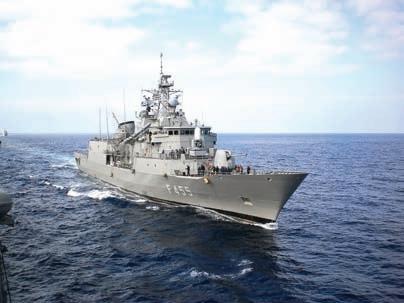







MUSINGS FROM RUSSIA INDIA, RUSSIA POISED TO UPGRADE DEFENCE TIES
As Russian President Vladimir Putin is visiting India in October this year, the two countries are assured to take their defence and strategic relations to a new high with the signing of major defence agreements apart from marking the 20th anniversary of Strategic Partnership Declaration signed in October 2000
Defence Minister Rajnath Singh inspecting Guard of Honour during his visit to Moscow recently

By VINAY SHUKLA
M
oscow. Delhi that it was committed to ensure India’s defence and keep its sensitivities in mind. These signals were first given to Defence Minister Rajnath Singh in June, when he was in Moscow to attend the Victory Day Parade to mark the 75th anniversary of the Second World War in Europe. Putting aside the established protocol Russian Deputy Prime Minister Yuri Borisov with his entire team called on Singh in his hotel to discuss bilateral defence cooperation and assure India that its military requirements will be promptly met. Besides this, Defence Secretary Ajay Kumar had detailed parleys with Russian Deputy Defence Minister Col-Gen. Alexander Fomin on concrete issues of military supplies to India.
During his second Moscow visit in September to attend the Shanghai Cooperation Organisation (SCO) defence ministers’ meeting, Russian Defence Minister General Sergei Shoigu assured Rajnath Singh that Russia will not sell arms to Pakistan. On his part during talks with his Russian counterpart Sergei Lavrov, Dr Jaishankar reassured Moscow that India’s vision of Indo-Pacific is inclusive and not against any nation. Besides Russia-India-China (RIC) triangle, which also created conditions for talks between Indian and Chinese defence and foreign ministers to resolve LAC confrontation in larger global interests, New Delhi has also proposed an IndiaJapan-Russia triangle as the three nations share similar or common interests and concerns. The idea is that New Delhi joining Quad of US, Australia, Japan and India should be seen in a similar spirit and not as a challenge for Russia.
In his recently published book ‘The India Way’ EAM Jaishankar has specifically mentioned the need to “reassure” Russia besides engaging America and managing China. He has conceded: “refreshing India’s ties with Russia has required dedicated efforts.”
In this case we can say that these efforts were not in vain. Against the backdrop of Sino-Indian spat on LAC, Russia acted in the spirit of “special and privileged” strategic partnership with India. Russia, as the host, did not make any fuss over India’s withdrawal from Kavkaz-2020 military drills due to involvement of Chinese and Pakistani troops. On the contrary they quickly agreed to conduct joint naval drill on September 4-5 when Defence Minister Rajnath Singh and his Chinese counterpart were here for SCO defence ministers’ meet. Due to COVID-19 pandemic the two friendly navies conducted the 11th edition of INDRA Navy-2020, in non-contact-sea only PASSEX drill in the area close to strategic Malacca Straits near Andaman and Nicobar Islands.
MAJOR DEFENCE DEALS EXPECTED
Apart from the proposed Reciprocal Logistics Support Agreement, providing seamless
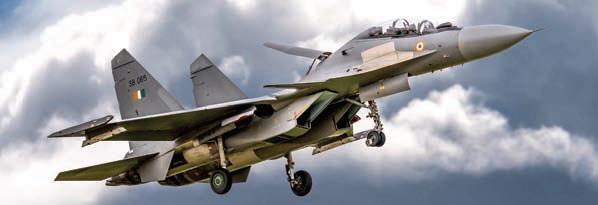


sailing and aviation support for the two countries’ navies and military aircraft at each other’s bases would be a major pact adding a new dimension to Indo-Russian defence cooperation. This acquires special importance in view of opening of northern shipping route passing through Russia’s mineral resources rich Arctic region. According to officials of the Federal Service for MilitaryTechnical Cooperation (FSMTC) with foreign lands the deal for the 21 MiG-29 along with upgradation of existing 59 MiG-29 aircraft and procurement of additional 12 Su30 MKI aircraft will be finalised this year. Earlier in July amid tension with China on LAC in Ladakh, the Defence Acquisition Council (DAC) had approved the MiG-29 procurement and upgradation from Russia is estimated to cost Rs. 7,418 crore, the Su-30 MKI assembled from the Russian kits will be procured from Hindustan Aeronautics Ltd (HAL) at an estimated cost of Rs. 10,730 crore. “We know that due to objective reasons, the Indian leadership decided to accelerate the allocation of funds for the purchase of the specified aircraft. Negotiations are already underway. We count on signing contracts, including for six Kamov Ka-31 naval helicopters, by the end of 2020,” FSMTC spokesperson Maria Vorobyova was quoted as saying by the local media.
Meanwhile, the two sides have agreed to operationalise joint venture (JV) at Korwa near Amethi in Uttar Pradesh, India for the production of advanced AK-203 automatic rifles to manufacture 700 thousand rifles for the Indian Army. The Indian team headed by the Secretary of Defence Production Raj Kumar had series of meetings with key defence industry officials to clinch deals for the production of spares and critical components for the Russian origin platforms under Make in India programme.
However, another big ticket deal for the 200 multi-role utility Ka226T helicopters offered in 2014 under Make in India policy still hangs in balance and the recent talks have failed to make any headway although Russian Helicopters have set up a JV with HAL. Russia has reconfirmed its commitment to deliver first batch of S-400 Triumf advanced air defence system in 2021 and speed up the remaining deliveries ahead of schedule.
GULF MONARCHIES EYEING BRAHMOS
As India and Russia have agreed to allow the export of BrahMos antiship cruise missiles to “mutually friendly” countries, there are reports of some Gulf Monarchies taking interest in the product of BrahMos Aerospace JV – the crown jewel of Indo-Russian defence cooperation.
It is understood that BrahMos export decision was taken after fulfilling the orders of the Indian Armed Forces and work satisfactorily proceeding for the BrahMos NG – next generation missiles with speed over Mach 6 and extended range. According to local media reports, a version of BrahMos capable of destroying Airborne Warning and Control System (AWACS) aircraft is under development for indigenous Light Combat Aircraft (LCA) Tejas fighter.
- The author is a Moscow-based independent analyst.
Clockwise top: Mr Singh along with his SCO counterparts in a group photograph; S-400 Air Defence System; IAF’s Su-30MKI inflight
“YOU CAN EXPECT THE SIGNING OF MAJOR DEFENCE DEALS AND AGREEMENTS DURING PRESIDENT PUTIN’S INDIA VISIT IN OCTOBER”
Indian Ambassador to Russia DB Venkatesh Varma on the sidelines of “Army-2020

AMIT COWSHISH
RAISING OF FDI CAP IN DEFENCE ENTAILS COMPLICATIONS
Government’s objective should be to harmonise the imperatives to make the process easy and positively attracting foreign investors to invest their money under the increased FDI cap of 74 per cent in defence, however, it is not to say that there is no case for raising the FDI cap or the national security concerns are not important
even years after
Sthe Ministry of Commerce and Industry proposed raising of the cap on foreign direct investment (FDI) in defence to 74 per cent, this has become a reality. Following the Union Cabinet’s approval, the Department for Promotion of Industry and Internal Trade (DPIIT) issued a formal notification on September 17 raising the cap through the automatic route from 49 per cent to 74 per cent.
But this comes with a rider: the foreign investment will be subject to scrutiny on grounds of national security and the government reserves the right to review any foreign investment that affects national security. The way the clause is worded seems to imply that there would be a pre-investment scrutiny on grounds of national security and, in addition, the government may review the investment at any stage after it has been made on the same grounds. This seems to apply to all foreign investments in the defence sector.
The raising of the FDI cap does not come as a surprise. While announcing the fourth tranche of the fiscal package for rejuvenating the economy, savaged by the Covid-19 pandemic, Finance Minister Nirmala Sitharaman had indicated on May 16 that the FDI limit in the defence manufacturing sector under the automatic route will be so raised. What does come as a surprise, however, is the national security clause.
The FDI policy so far permitted FDI up to 49 per cent in the defence sector where the industry is subject to industrial licensing under the Industries (Development and Regulation) Act, 1951, and for manufacturing of small arms and ammunition under the Arms Act, 1959. Investment up to this limit was permitted through the automatic route, but any investment beyond it could be made only with the prior approval of the designated government agency wherever it was likely to result in access to ‘modern technology’ or for other reasons considered justified by the agency to permit it.
These conditions have been retained for investments exceeding 74 per cent, which will now also be subject to the national security clause. This is not as problematic as the fact that all investments below 74 per cent will also apparently be subject to the national security clause which, as mentioned earlier, could be applied before and after the investment is made. This creates a barrier which was not there earlier as these tasks cannot be left to be carried out by the investors on their own, not least because, besides being dynamic, the concept of national security is too difficult to define in specific terms. These conditions attached to foreign investment may consequently end up introducing an element of uncertainty for the investors. As it is, the government has never clarified what constitutes
‘modern technology’ or what are the other grounds on which the government
would be inclined to approve a proposal for, say 100 per cent FDI and now the investors will also have contend with the ambiguity surrounding the parameters of national security which may be applied for pre-investment scrutiny and post-investment review by the designated government agency.
The focus on FDI policy reforms, which anyway do not seem to make things easier for the prospective investors, distracts from the fact that even under the best of the policy regimes, the foreign investors may refrain from investing in the Indian defence sector unless there is a business case for it. The signals coming from the Ministry of Defence (MoD) are confusing, even discouraging. The emphasis on self-reliance is unexceptional but, in the absence of any categoric assurance from the MoD that all companies registered in India will be treated at par irrespective of the extent of foreign investment in them, this policy also narrows down the window of opportunity for the foreign companies considering investment in India.
The Defence Procurement Procedure (DPP) 2016 that governs capital acquisitions for the armed forces and the Coast Guard virtually prohibits companies with FDI exceeding 49 per cent to participate in the projects under the Strategic Partnership Model (SPM) which, it may be recalled, has been designed by the MoD for mega projects involving manufacturing of aircraft, helicopters, submarines,
THE NATIONAL SECURITY CLAUSE, WHICH COULD BE APPLIED BEFORE AND AFTER THE INVESTMENT IS MADE, CREATES A BARRIER WHICH WAS NOT THERE EARLIER AS THESE TASKS CANNOT BE LEFT TO BE CARRIED OUT BY THE INVESTORS ON THEIR OWN, NOT LEAST BECAUSE, BESIDES BEING DYNAMIC, THE CONCEPT OF NATIONAL SECURITY IS TOO DIFFICULT TO DEFINE IN SPECIFIC TERMS

armoured fighting vehicles, and the main battle tanks. Such companies are also ineligible to participate in the projects under the Make-I category. There has to be a reasonable assurance for the foreign investor that the investee company will be able to sell its products to the MoD, which is the only buyer in the defence sector. But, given the frustrating procedural complexities and the persistent resource crunch faced by the MoD, there can be no such assurance. True, the foreign companies can still invest for taking up smaller projects in which their participation as prime vendors is not barred, but it remains to be seen if this can bring in substantial investment. It also remains to be seen if the foreign companies would find it attractive enough to make heavy investments in export-oriented ventures in the face of uncertain prospects of finding new markets for export. This would be evident from the current list of the largest importers of arms: Saudi Arabia, Egypt, Australia, China, Algeria, South Korea, United Arab Emirates, Iraq, Qatar, and Pakistan. Some of these countries we cannot export to, even if they evince interest, whereas the others may prefer to buy from the already established sources of supply. It is not going to be easy to break into the established defence markets.
It is not to say that there is no case for raising the FDI cap or the national security concerns are not important, but these need to be harmonised with the imperatives of not only making it easy, but positively attractive, for the prospective foreign investors to consider India as a favoured destination for putting in their money, if indeed that is the government’s objective.
– The author is Ex-Financial Advisor (Acquisition), Ministry of Defence
R
ecipient of Padma Bhushan award for contributions to Trade and Industry, Baba N. Kalyani, Chairman and Managing Director – Bharat Forge Limited (Kalyani Group) is also known for his contribution in furthering trade and business cooperation between Sweden and India. He was made Commander First Class of the Royal Order of the Polar Star by the Swedish government. He attended BITS Pilani and Massachusetts Institute of Technology (MIT) for his BE (Hons) in Mechanical Engineering and MS respectively.
In an interview to PK Ghosh of Raksha Anirveda, he detailed out the Group’s diversification strategy to become a big electronics and embedded business systems leader over the years from a mechanical company. Edited excerpts:

Kalyani Group is a diversified group. Tell us about the important growth drivers you foresee in your defence business despite the pandemic adverse impact. Do you see your group to be on course to position itself as a major defence player globally by year 2025?
If you see world over, most defence companies have a history in metal and metallurgy. We have followed the same route, and defence for us has been themostnaturaldiversification. I seeour defence business growing tremendously in near future. We have conceptualised ourselves as a partner of the Indian Armed Forces to produce systems and components that India needs, and using the same capability to supply similar products to certain global markets. The company continues on its growth trajectory in the defence segment by diversifying into additional business opportunities, while maintaining Artillery systems and Protected Vehicles as its mainstay. The pandemic may have been a dampener for some time, but it has also been a major learning curve making the country realise the importance of self-reliance. The recent slew of positive policy changes announcedbyMoDis a reflectionofsame and has given us tremendous hope. The preference which the recently released draft DAP 2020 lays on indigenisation and indigenous products has the potential to change the face of defence production competency in this country. The minimum indigenous content required across procurement categories is a promising 50 per cent. The government is also targeting over US$5 billion exports in defence production by 2025. The import embargo list is another milestone done right. All of these present huge opportunities for domestic companies including ours. Above call, our PM’s vision of ‘Atmanirbhar Bharat’ has renewed our faith in indigenisation and will steer the future growth.
Diversification is the key component in today’s business, and Bharat Forge too has transformed itself with time. How has been your experience with regards to transforming your business from mechanical to electronics and embedded business systems?
The company has meticulously derisked its business model by diversifying into multiple industries such as Automotive, Defence, Aerospace, Oil
and Gas, Mining and Construction, Power, E-mobility, etc. Apart from industrial diversification, the company has also diversified geographically with a global presence in five countries. We continue to evaluate and add new geographies and new customers to our portfolio. Diversification across industries has helped us in creating resilience during downturns. A wider global footprint ensures that the impact of countryspecific shocks becomes minimal. Over the last decade, we have worked towards revenuediversification,investingforthe future and capability enhancement while simultaneously strengthening the balance sheet. As we transform our business from mechanical into electronics and embedded system business, we are bringing entire capabilities of our group at a place to make it interactive, where we get knowledge from a domain and replicate in the other to create extraordinary solutions.

Kalyani Group is following
Three-horizon strategy. What is it all about? Please elaborate?
Technology and innovation have been the cornerstones of the Kalyani Group story, and the three horizon strategy is a consolidation in that direction. In horizon1, we focus on existing products and capabilities which can be supplied to existing and new customers. In horizon2, the strategy is to supply newly developed products. We have made investments towards these developments so that in the next three to four years when these technologies or products come in mainstream, we can localise and supply unique and proprietary solutions to our Indian and global customers. In horizon3, we work towards advance technology development – combining electronics and mechanical capabilities internally and other domain specific knowledge, and innovate.
The government has taken many proactive steps and policy measures to realize the long
Bharat Forge Advanced Towed Artillery Gun System (ATAGS)
cherished dream of self-reliance (atmanirbharta) in defence. In realistic terms, the result so far has been below par. What are the major pain points that still act as barrier? Do you think that by next decade India will be able to achieve its selfreliance goal? Your views?
I saythiswithmuchconfidence that yes India will be able to achieve its self-reliance goal by the next decade. See, defence industry is highly technology driven arena. Here you will find the most advanced technologies having huge learning curve and which need niche expertise and skills. There is a whole ecosystem which needs to be created with various stake holders comprising of government, research institutes, academia, production units, etc. World over, the developed countries have become self-reliant in defence technologies and production after decades of research and work. Comparatively, Indian private industry has been exposed to defence production very recently. The good thing is that we have realised the importance of self-reliance and have started working towards its realisation. Look at all these recent announcements – they are making up for all the time lost and shaking off the long set inertia from the system. The private sector adapts itself better to rapidly changing technology - and with continued government support, it will help India realise its dream of becoming Atmanirbhar.
According to Prime Minister
Narendra Modi, Atmanirbhar Bharat does not mean that India has to be self-reliant in the manufacturing sector on its own rather it paves the way for codevelopment and co-partnership with global companies to achieve self-reliance, particularly in aerospace and defence sector. Your opinion?
You are right. The idea is to move away from being a mere manufacturing hub to a technology holding, IP owning country. But, it will be foolhardy to say that we will not indulge in global technology collaborations and investments. Given the capital and technology intensive
nature of defence industry and the present maturity level of our defence ecosystem, global partnerships for R&D, codevelopment and innovation will play a substantial role in helping us achieve Atmanirbharta. Kalyani M4 fully automated and can shoot andscoot. A robustbattlefield solution, which I am sure will become the backbone of Indian Artillery in future. Other than ATAGS, we have developed a series of 155mm/52/45/39 cal and 105/37 cal guns which
You have invested a lot include ultra-light howitzers in defence business and and mounted platforms. have joint ventures with More importantly, we have Rafael Israel and others. acquired and developed Earlier this year, you all kinds of soft skills and partnered with JSC Arsenal hard skills when it comes and Paramount Group. to Artillery technologies. Additionally, you have We have all the knowledge invested in start-ups like about the metal, the Aeron Systems and HoloSuit. metallurgy, the ballistics, How well this multi-faceted the pressure curves in the investments have worked barrels, the structural force, and do you plan to invest the recoil pressure that more in near future? comes on the gun and the Over a period of about system architecture. We eight to nine years we Mine Protected Vehicle -MPV know the nuts and bolts have created a very large of how a gun works. So we portfolio, which spans across Artillery Bharat Forge is developing four have both technology and technology Guns, Protected Vehicles, Air Defence platforms of artillery gun, all understanding. That I feel is our biggest Systems, Ammunition, Small Arms and 100 per cent indigenous. Last month, achievement. This gives us a clear edge Defence Electronics. We are now well one platform of the artillery gun and made us the pioneers of Artillery poised to venture into additional fields underwent final user trials. Can you in the country. All our gun systems of Marine products, small Jet Engines, elaborate on the progressive are under various stages of extensive Product improvements/upgrades, etc. development outcome of this artillery trials, even during this COVID times. To deliver these solutions, we are gun and other platforms that are We hope that once all these trials are continuously enhancing our under various stages of trials? What done the orders will be placed. Defence engineering expertise, integration are your expectations and future procurements are a long-drawn process advantage, and innovation capabilities. outlook with regards to defence and it has to follow its own cycle. We are Accordingly, investments have been orders pipeline including exports also looking at the global markets for made by the group to develop and order? our products. manufacture next-generation weapons Yes, ATAGS is inching towards the and defence systems. The aim of final stages of user trials. It has What are your plans for Aero investments in defence startups is to performed extremely well in all its trials India 2021? Kindly provide imbibe technologies and build and has demonstrated its superior insights into the product offerings competencies in Augmented Reality consistency, accuracy and range. We are you would be showcasing at the (AR), RF Systems, INS, Artificial verysatisfiedwithitstrialsperformance. event? Intelligence (AI) and Data Analytics, Even in the latest trials held at Pokhran Our technology centre at etc. Similarly, all our partnerships with in early September, BFL version fired Bengaluru has been doing some global majors offer us complementing beautifully and without any glitch very exciting work in jet engines and capabilities which further our purpose whatsoever. DRDO has done some have ab-initio developed a series of 40, of creating world class defence fantastic work with its design, and the 80, 120 and 160 kg thrust jet engines. products. These acquisitions and quality of the manufacturing is par- These will be on display during the aero partnerships are our capability excellence. Look at some of its show along with some key products enhancing tools and we continue to parameters - it far outweighs its from KRAS and new offerings from our invest in them. competition. It offers higher range, is aerospace vertical.
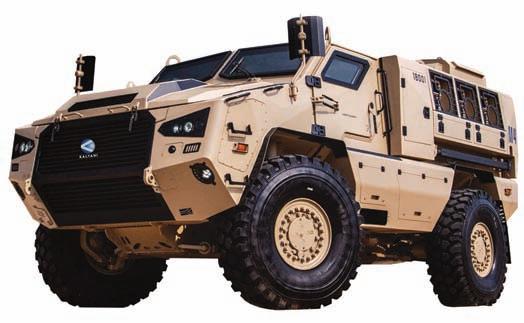

ASR-NG DEPLOYABLE COMBINES SUPERIOR PERFORMANCE WITH AIR TRANSPORTABILITY A
SR-NG Deployable from HENSOLDT, the leading independent sensor house, is a rapidly deployable ATC radar complying to ICAO, Eurocontrol and safety standards for civil and military ATC. It capitalizes on the superior detection performance and accuracy of the stationary ASR-NG variant. It is contained within two 20 foot ISO containers, and is easily transportable by rail or road, or in one C-130 type aircraft. The radar delivers an air picture to controllers within 6 hours of deployment. The ASR-NG Deployable is in full-scale production. traffic control and identification systems for military and civilian applications.
ABOUT HENSOLDT
HENSOLDT is a pioneer of technology and innovation in the field of defence and security
electronics. Based in Taufkirchen near Munich, the company is a German Champion with strategic leadership positions in the field of sensor solutions for defence and non-defence applications. HENSOLDT develops new products to combat a wide range of threats based on innovative approaches to data management, robotics and cyber security. With approximately 5,500 employees, HENSOLDT generated revenues of 1.11 billion euros in 2019.
“The versatility of our new product combined with ASR-NG’s superior performance makes it ideally suited for ATC purposes in joint and combined missions of expeditionary units”, explains HENSOLDT-CEO Thomas Müller. “Thus, it improves the efficiency of combined air, ground and naval forces while contributing to safe operations and avoidance of friendly fire.”
ASR-NG consists of an integrated primary and secondary radar system. The primary radar helps to detect non-cooperative objects such as small aircraft that do not have transponders or hostile aircraft. It is based on a semiconductor

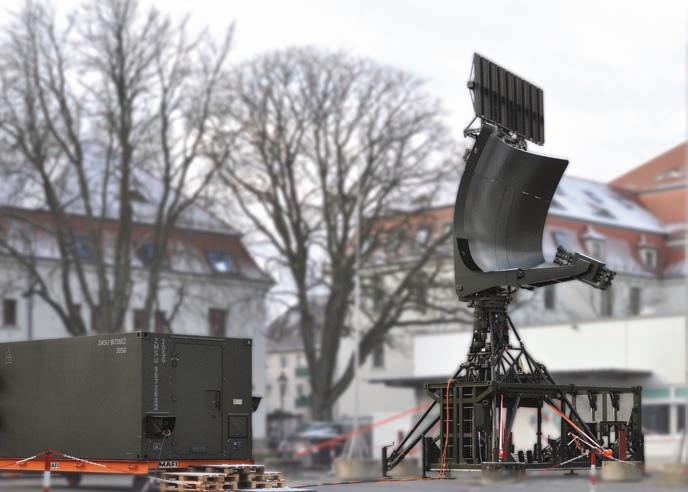
transmitter and includes special signal processing techniques for wide-area surveillance and windfarm mitigation. The secondary radar, MSSR 2000 ID, ensures the automatic identification of cooperative aircraft. This secondary radar meets the new “Mode S/ Mode 5” air traffic control standard, which greatly improves aircraft identification queries and is currently being introduced in all NATO and allied forces.
HENSOLDT supplies customers from all over the world with air
COVER STORY: IAF DAY SPECIAL IAF CELEBRATES 88TH BIRTHDAY WITH LATEST INDUCTION OF RAFALE IN ITS ARSENAL
Indian Air Force is celebrating its 88th birthday with the induction of French fighter jet Rafale into the service which provides much needed leverage to counter the adversaries on the borders
A
By SRI KRISHNA
s the Indian Air Force (IAF) celebrates its 88th year of birth on October 8, 2020, it has indeed been a watershed year for the world’s fourth largest Air Force with a strength of about 1,500 aircraft and 1,70,000 personnel or air warriors who have covered themselves with glory and continue to play a critical role in both civilian and defence sector guarding the nation. The force took a major stride this year in the midst of raging COVID 19 as it inducted the French fighter aircraft Rafale with five of them touching down at the Ambala Air Force base on July 27 amid a rousing welcome and comes at a time when the borders with both the neighbours – China and Pakistan – remain tense.
Indian Ambassador to France Arun K. Singh (C) in the Rafale cockpit during a delivery ceremony with Dassault Aviation Chairman and Chief Executive Officer Eric Trappier (R) and Thales Executive Vice President, Defence Mission Systems, Pierre Eric Pommellet
Defence Minister Rajnath Singh and his French counterpart Mrs Florence Parly as Chief Guest formally inducted the aircraft in a ceremony held at Ambala Air Force Station to mark the Rafales’ induction into the service of IAF on September 10.
So far, India has bought 36 twin-engine fighter planes from Dassault Rafale for an estimated cost of Rs 58,000 crore, through an inter-governmental agreement (IGA) signed in 2016.
The air warriors have through the five wars that the country fought since Independence lived up to their motto “Touch the sky with the glory.”
The first IAF Day was observed in 1932. It has been celebrated with incredible energy and intensity nationwide at different air stations. The enactment of the IAF Act 1932 marked the auxiliary status and enforced the adoption of the Royal Air Force uniforms, badges, and brevets. On April 1, 1933, the IAF commissioned its first

www.raksha-anirveda.com IAF’S JOURNEY FROM BIPLANES TO MMRCA
From biplanes to the long awaited French Medium Multi-Role Combat Aircraft (MMRCA) Rafale which joined the Indian Air Force (IAF) rated as the fourth largest air force in the world, it has indeed been a long 88 year old journey. The force has during this period and specially since Independence seen action in four wars and covered itself with glory. Though it is still short of its full strength of 42 squadron, the exercise to boost it to this level is on and the focus has been on acquiring as many of the aircraft from indigenous industry and it is the force which has truly lived up to Prime Minister Narendra Modi’s slogan of Atmanirbhar Bharat and continues to make strides in this direction.
In the prevailing scenario with tension along both the Sino-Indian border in the northern region of Ladakh along the Line of Actual Control (LAC) as also Line of Control (LOC) with Pakistan which continues to push in terrorists into the Union Territory of Jammu and Kashmir and colluding with China, the role of the IAF does gain prominence.
The Chief of Air Staff, Air Chief Marshal RKS Bhadauria, exudes confidence that the air warriors can face any type of situation including a twofront war which has been much talked about.
He has been a strong votary of indigenisation in platforms for the Air Force and also recently test-flew the prototype Hindustan Turbo Trainer-40 (HTT-40) giving a clear signal of a new, positive attitude in the IAF. Bhadauria who took over as the 26th Chief of Air Staff (COAS) on September 30, 2019, it has been challenging times on the borders and the IAF has been on the alert 24X7 and it was under his command that the Rafale aircraft joined the IAF amid heated debate in the political arena.
It is to the credit of the Air Chief Marshal Bhadauria that he gave a clear signal of a new, positive attitude in the IAF towards indigenous aircraft, when he test-flew the prototype HTT-40 at Hindustan Aeronautics Ltd (HAL) in Bengaluru.

squadron, No 1 Squadron, with four Westland Wapiti biplanes and five Indian pilots. The Indian pilots were led by British Royal Air Force (RAF) Commanding Officer Flight Lieutenant (later Air Vice Marshal) Cecil Bouchier.
After Independence in 1947, the name Royal Indian Air Force (RIAF) served in the name of Dominion of India. In 1950, with the government’s transition to a Republic, the prefix Royal was removed.
The IAF has not only played the role of defending the nation but also in times of natural disasters given a major helping hand to the civil authorities and captured the hearts of the civilian population who would be ever grateful.
Among the major operations undertaken by the IAF include Operation Vijay, Operation Meghdoot, Operation Cactus, and Operation Poomalai.
The air warriors have indeed played an exemplary role in UN operations worldwide, the annexation of Goa from Portugal, and various wars with Pakistan and also as the Indian Peacekeeping Force (IPKF) in Sri Lanka.
With Prime Minister Narendra Modi’s focus on Atmanirbhar Bharat, the IAF too has been taking major strides towards having its weaponry made indigenously though of course the first Indian developed fighter aircraft is HAL’s HF-24 Marut. It is the first in Asia to go beyond the test phase.
Ever since Air Chief Marshal RKS Bhadauria took over as the 26th Chief of Air Staff (COAS) on September 30, 2019, it has been challenging times on the borders and the IAF has been on the alert 24X7 and it was under his command that the Rafale aircraft joined the IAF amid heated debate in the political arena.
It is to the credit of the Air Chief Marshal Bhadauria that he gave a clear signal of a new, positive attitude in the Indian Air Force (IAF) towards indigenous aircraft, when he test-flew the prototype Hindustan Turbo Trainer – 40 (HTT40) at Hindustan Aeronautics Ltd (HAL) in Bengaluru.
Bhadauria became the

IAF’s Su-30MKI
IAF Chief Air Chief Marshal RKS Bhadauria inside HTT-40 cockpit

HAL’s LCA Tejas
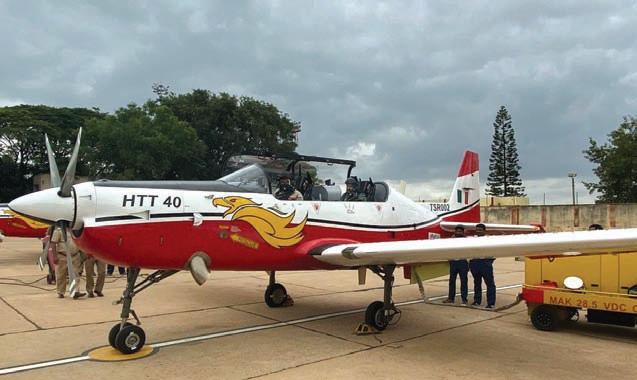
BHADAURIA BECAME THE FIRST SERVING IAF CHIEF TO FLY AN HALDEVELOPED AIRCRAFT AT THE PROTOTYPE STAGE. AN ACCOMPLISHED TEST PILOT WHO HAS TEST-FLOWN THE TEJAS FIGHTER, WAS TAKEN THROUGH THE GRUELLING “SIX-SPIN ROUTINE” IN WHICH THE HTT-40 PROTOTYPE WAS ALLOWED TO SPIN SIX TIMES BEFORE THE PILOT RECOVERED IT INTO LEVEL FLIGHT

first serving IAF chief to fly an HAL-developed aircraft at the prototype stage. An accomplished test pilot who has test-flown the Tejas fighter, was taken through the gruelling “six-spin routine” in which the HTT-40 prototype was allowed to spin six times before the pilot recovered it into level flight.
Among the various types of aircraft currently in the inventory of the IAF include MiG series, Sukhoi Su-30, HAL Tejas, SEPECAT Jaguar, Boeing 707, Ilyushin series, Helicopters like HAL Dhruv, Unmanned Aerial Vehicles (UAVs) for reconnaissance and surveillance and missiles with the latest induction being the French fighter Rafale.
Even though women being inducted into the armed forces is not a new concept, but their employment in the Indian Armed Forces is a practice that has been adopted in the last just over two and a half decades.
The IAF started inducting women as Transport and Helicopter pilots in 1994. These officers have also performed well irrespective of job content, including in missions related to disaster management.
In 2015 a decision was taken to induct women as fighter pilots and they are currently under training. Modern air combat involves management of aircraft systems and in this digital age, one may not even see the enemy in the air before shooting him or her down with beyond visual range missiles. Fighter pilots need to be physically and mentally fit to withstand high ‘G’ forces while manoeuvring and be skillful enough to get into a position of advantage to shoot down the enemy in the event of a situation of close combat.
There was another feather in the cap of the IAF as Flight Lieutenant Shivangi Singh is set to become the first woman fighter pilot of India to fly the Rafale combat aircraft. Shivangi Singh, who hails from Uttar Pradesh’s Varanasi, was commissioned into the Indian Air Force (IAF) in the year 2017 as part of the second batch of women fighter pilots In the final analysis, it is really not a contest of skills between male and female fighter jockeys as female pilots flying transport and helicopters in the IAF have adequately proved their mettle and in no way are they less competent than their male counterparts.
The induction of women into the IAF has enabled to double the base from which the officer cadre of the IAF is selected. Gradually the number of women officers is increasing.
HAL Dhruv Advance Light Helicopters
– The writer is a senior journalist and media consultant.
DAC ACCORDS PROCUREMENT PROPOSAL WORTH OVER `11,000 CRORE IN TWO TRANCHE IN AUGUST AND SEPTEMBER


N
ew Delhi. In a boost to domestic defence production as well as for fulfilling the Indian Armed Forces requirement from foreign players, Defence Acquisition Council (DAC) meeting held under the Chairmanship of Defence Minister Rajnath Singh on September 28 approved proposals for Capital acquisitions of various equipment at an approximate cost of Rs 2,290 crore. These procurements will be completed from domestic
industry as well as Foreign vendors.
Under the Buy Indian (IDDM) category, the DAC approved procurement of Static HF Tans-receiver sets and Smart Anti Airfield Weapon (SAAW). The HF radio sets will enable seamless communication for the field units of Indian Army and Indian Air Force and are being procured at an approximate cost of Rs 540 crore. The Smart Anti Airfield Weapon being procured at an approximate cost of Rs 970 crore will add to the fire power of Indian Navy and Indian Air Force.
Further, to equip the Frontline Troops of the Army, the DAC also accorded approval for procurement of SIG SAUER Assault Rifles at an approximate cost of Rs 780 crore. Earlier on August 11, to strengthen the Armed Forces by relying on indigenous capability to take forward the initiative on ‘Atmanirbhar Bharat’, the DAC had accorded approval for capital acquisitions of various platforms and equipment worth Rs 8,722.38 crore.
With Defence Public Sector Undertaking (DPSU) Hindustan Aeronautics Limited (HAL) having successfully developed Basic Trainer Aircraft (HTT-40) Prototypes and certification process underway, the DAC approved procurement of 106 Basic Trainer Aircraft to address the basic training requirements of the Indian Air Force (IAF).
Post Certification 70 Basic Trainer Aircraft will be initially procured from HAL and balance 36 after the operationalisation of HTT-40 fleet in IAF. As far as the Indian Navy is concerned, to improve its fire power, the DAC approved procurement of an upgraded version of Super Rapid Gun Mount (SRGM), which is fitted as the main gun onboard the Navy and Indian Coast Guard (ICG) warships, from Bharat Heavy Electricals Limited (BHEL). The upgraded version of SRGM has enhanced capability to perform against fast manoeuvring targets like missiles and Fast Attack Crafts (FACs), and increase the maximum engagement range.
In view of the availability of requisite capability for indigenous development of the ammunition, both in terms of ‘Manufacturing’ and ‘Technology’, the DAC approved procurement of 125 mm APFSDS (Armour Piercing Fin Stabilised Discarding Sabot) ammunition for Indian Army as a ‘Design and Development Case’. The ammunition being procured will have a 70 per cent indigenous content. The Defence Acquisition Council also gave approvals that are likely to speed up the procurement of AK-203 assault rifles and Unmanned Aerial Vehicle (UAV) upgrades..
CAN IAF GROW ON INDIGENISATION?
The MKII version of twin-engine aircraft Tejas could be a choice, and become the mainstay of the IAF to meet its dire need of fighter squadrons with the depleting number of serviceability aircraft, but can HAL deliver the numbers and in time? Can IAF Grow on Indigenisation? Such questions need concrete answers
By AIR MARSHAL DHIRAJ KUKREJA (RETD)
The serious eyeball-to-eyeball face-off between the armies of India and China in Aksai Chin, Ladakh, has forced a substantial mobilisation of other two Services from both sides. Defence analysts the world over, arm-chair strategists mainly in India, and propaganda media in China - are closely comparing the strengths and weaknesses of the militaries of the two sides across the Line of Actual Control (LAC). Under these circumstances there is a need to examine the state and growth plan of Indian Air Force (IAF) through indigenisation.
Indian Air Force Rafale on ground
There are two reasons for why only the IAF is being examined here – one, that the IAF has recently taken delivery of five Rafale aircraft on July 29, which have now been officially inducted into service in September. The second reason is that since the IAF’s 88th anniversary falls on October 8, it is hence but natural that the IAF would be in the limelight and its capabilities examined threadbare. There is actually a third reason too: having been a ‘man in blue’ for almost 40 years, the IAF is close to my heart, and my heart bleeds for the IAF!
Before proceeding any further, it is imperative to understand the need for building up the combat aircraft strength. It needs to be kept in mind that the IAF is at an all-time low squadron strength; as against the authorised 42 squadrons, the IAF is at 30 (may be even 29) with every possibility of the numbers going down further if some more squadrons are allowed to phase out because of low availability of serviceable aircraft. With China breathing down our neck in Ladakh with surreptitious moves in other sectors all along the LAC, and its protégé, Pakistan, ever keen to needle India on the Western border, the IAF has to be prepared to simultaneously face two adversaries. Hence, the need to grow in numbers!
How is it that the IAF landed up in such a critical situation? It was two decades ago, in 2001, that the government was first apprised by the IAF of the need to acquire additional fighters. IAF at that stage was content to have been offered an upgraded version of the Mirage 2000; the option finally got foreclosed in 2006, when Dassault closed the Mirage 2000 production-line after repeatedly checking with India and receiving no firm commitment. The process to acquire 126 Medium Multi-Role
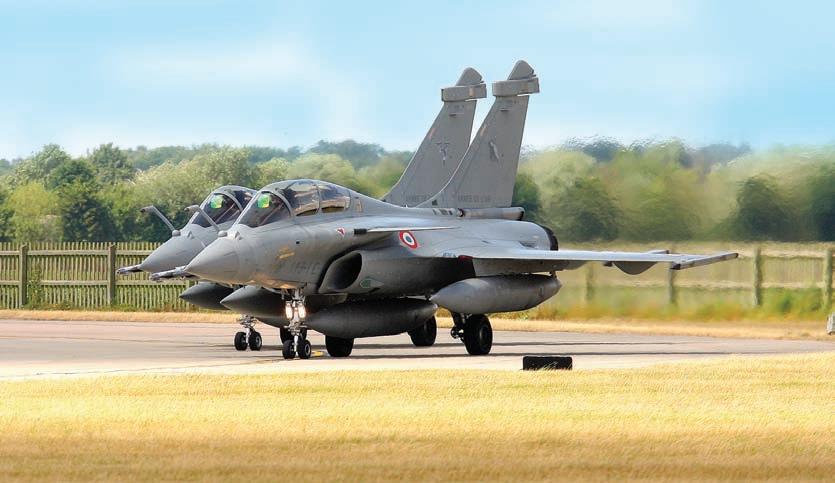
Combat Aircraft (MMRCA) was then initiated in 2007; the French Dassault Rafale was announced as the decisive choice in 2011, after an aggressive competition among the world’s top available aircraft manufacturers, years of lobbying by foreign governments, and extensive trials by the test pilots of IAF to check on the advertised capabilities of each aircraft that was on offer.
Whether the aircraft was to be manufactured by the private sector, or by HAL, almost placed the entire scheme in a limbo once again. Finally, the IAF, in a do-or-die bid to acquire new aircraft, placed its report to the Government of India (GoI) of the dire straits that it was in, leading to 36 Rafale aircraft being contracted for in 2016 in a direct governmentto-government sale; five aircraft, as aforementioned, have been delivered, with subsequent deliveries of similar numbers every quarter or so, completing the delivery by 2022.
Meanwhile the indigenous Light Combat Aircraft (LCA), christened as ‘Tejas’, and having a very chequered history, appeared on the scene. The programme, which commenced in the 1980s with an aim to replace the ageing MiG-21 aircraft, had its first flight in 2001. The delayed Design and Development (D&D) programme, and the aircraft’s first flight after nearly 20 years, have been the main reasons for only around 20 aircraft to be delivered to the IAF thus far. The first squadron was formed in 2016, and the second LCA squadron has just been formed in May this year.
Delayed acquisition in sufficient numbers of fourth generationplus fighters and slow induction of the LCA are the main cause of the depleted state that IAF fight fleet is in today. By 2022, IAF will at best have a third LCA squadron, and two of Rafale aircraft, while waiting to phase out are at least five squadrons. The numbers could, therefore, deplete further, if the IAF is unable to meet the serviceability requirements of its old fleets. The induction of C-130J, and the C-17 aircraft in the transport fleet in the recent past, and the Apache and Chinook helicopters in the last two months have placed these two fleets in a comfortable position.
As the IAF goes in for subdued celebrations of its 88th anniversary, due to the ongoing pandemic, the Prime Minister (PM) has exhorted the entire country to go in for products “Made in India”. This has been his pet project since 2014, specially for manufacturing in the defence sector, but never really took root. Now, during the pandemic, his ‘war cry’ for “Go Vocal for Local” and “Atmanirbhar Bharat”, has invigorated the people’s thinking, and from simple gaming-apps on mobile phones to big-ticket manufacturing is being looked into and has also taken-off in some sectors.
While addressing a seminar on self-reliance organised by the Ministry of Defence (MoD), the PM urged the Armed Forces to reduce imports and purchase Indian products with confidence. He also dwelt on the need to make the country a defence-manufacturing hub with active involvement of

IAF’s MiG-21
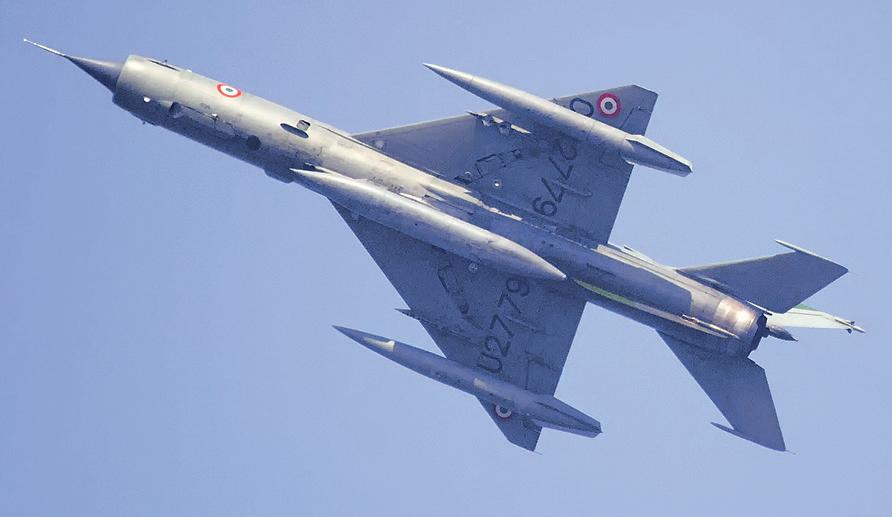
HAL’s LCA Tejas
PM MODI HAS EXHORTED THE ENTIRE COUNTRY TO GO IN FOR PRODUCTS “MADE IN INDIA”. NOW, DURING THE PANDEMIC, HIS ‘WAR CRY’ FOR “GO VOCAL FOR LOCAL” AND “ATMANIRBHAR BHARAT” HAS INVIGORATED THE PEOPLE’S THINKING, AND FROM SIMPLE GAMING-APPS ON MOBILE PHONES TO BIG-TICKET MANUFACTURING IS BEING LOOKED INTO AND HAS ALSO TAKENOFF IN SOME SECTORS
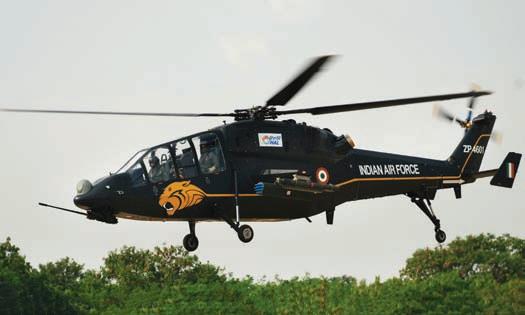
Indian Air Force Chinook
HAL’s Light Combat Helicopter
MANUFACTURING OF THE TEJAS MKII BE ACCELERATED, AND IF POSSIBLE, UNDER THE STRATEGIC PARTNERSHIP POLICY BETWEEN HAL AND THE PRIVATE SECTOR, AND THIS WILL BE A BOOST TO INDIGENISATION
the private sector in Research and Development (R&D) too. While the private sector was permitted into the much-restricted area of defence manufacturing, as far back as 2003, results have not been very encouraging. Off-therecord, main reason aired for not encouraging the private sector into defence manufacturing is national security; it is ironical, that while the Indian private sector is not egged on, foreign private vendors can sell their goods to the Indian Armed Forces and police forces, from aircraft to rifles! Whither national security?
Much euphoria and hype has been generated with the induction of Rafale aircraft. One needs to understand that IAF’s acquisitions are an ongoing process for modernising and growth of its fleets, which are diminishing in quality and quantity due to obsolescence and attrition. There is a definite urgency to replace the old MiG21, MiG-23, and MiG-27 fleets by a high-technology aircraft in the immediate foreseeable future. While the IAF would prefer a twin-engine aircraft the MKII version of the Tejas could be a choice, and could also become the mainstay of the IAF, but can HAL deliver the numbers and in time? The present under-developed version, the time needed to develop the newer MKII version, and the HAL output, will keep the IAF in a state of anxiety, as new aircraft from foreign vendors will not be encouraged. It is, therefore, imperative that manufacture of the Tejas MKII be accelerated, and if possible, under the strategic partnership policy between HAL and the private sector.
It is not just an aircraft that the IAF desires; aero-engines are also in great demand. The technology is one of the closely-held secrets and to get an Original Equipment Manufacturer (OEM) to part with it through technical collaboration is an extremely difficult task, almost next to impossible. Development of high-performance alloys and materials has been done for a very successful Indian space programme, but sadly, has been lacking in the aero-engine manufacturing programme.
The Kaveri aero-engine project of the Defence Research and Development Organisation (DRDO) has failed to take-off. French collaboration to upgrade this engine also seems to have lost steam. Home-grown talent or Indian talent searched from abroad, with development of highperformance alloys and materials, could lead to a breakthrough in this another ‘hot’ project.
Only a few countries dominate the world aerospace manufacturing domain. Aerospace technologies are state-of-the-art, involving high manufacturing accuracies and large investments. Notwithstanding the optimism created by Atmanirbhar push, India’s success in space programmes, and huge military aviation demands, the defence aerospace sector, however, continues to be ‘work-in-extremely-slowprogress’(Emphasis intentional).
Notwithstanding the recent increase in FDI, and the permission to the private sector to enter the defence manufacturing since long, the MoD seems to be throttling itself with self-denial by constantly shifting goal-posts for the private sector; a sector which has been acclaimed globally into aero-space manufacturing.
Is the reader aware that the ‘Marine One’, the Sikorsky-92 helicopter that the US president flies, has its cabin manufactured in Hyderabad by a Tata company – or the Chinooks and Apache helicopters have their cabins also made by the Indian private sector? The best aircraft manufacturing companies in the world have acknowledged the capacity and capabilities of the Indian private sector.
When will we wake up?

WITH GOVT’S FOCUS ON ATMANIRBHAR BHARAT DPSU BHARAT ELECTRONICS UPBEAT ON DEFENCE BUSINESS
Bengaluru: With the government’s focus on Atmanirbhar Bharat, defence public sector undertaking (DPSU) Bharat Electronics Limited (BEL) is upbeat about its business prospects in the defence sector though it’s facing the prospect of short-term adverse impact out of COVID-19. In fact, the Bangalorebased defence PSU was sitting on an order book of Rs 51,973 crore as on April 1 this year, according to company officials. Defence contributed 82 per cent of sales revenue of BEL in 2019-20, up from 68 per cent in the previous fiscal. The remaining 18 per cent revenue came from the non-defence sector.
BAE SYSTEMS CONTINUES MISSION-CRITICAL F-35 EW SYSTEM PRODUCTION
New Delhi. BAE Systems has been awarded a contract from Lockheed Martin for the production and delivery of additional electronic warfare (EW) systems for Lot 15, Lot 16 long lead, sustainment spares and retro fit kits for the 5th Generation F-35 Lightning II, providing advanced situational awareness and threat response capabilities that support critical missions in contested airspace. The contract follows BAE Systems’ production and delivery of more than 500 EW systems for the F-35 as a key system partner, matching Lockheed Martin’s airframe production. BAE Systems supports all stages of the product’s lifecycle, from development and production to sustainment. The company is actively designing and developing new capabilities to enhance the system’s offensive and defensive capabilities, and maintains its readiness for warfighters under a performance-based logistics sustainability contract.
DEFENCE MINISTER RAJNATH SINGH ANNOUNCES IMPORT BAN ON 101 DEFENCE ITEMS
New Delhi. In keeping with Prime Minister Narendra Modi’s focus on self reliance or Atmanirbar Bharat Initiative, Defence Minister Rajnath Singh took a major step in the defence sector to boost indigenous weapons over expensive foreign ones, by announcing import embargo on 101 items.
This move is part of the government’s efforts to boost domestic defence equipment manufacturers and the Prime Minister’s “vocal for local” and place Indian goods in the world market.
It is estimated that contracts worth almost Rs four lakh crore will be placed upon the domestic industry within the next six to seven years. Of these, items worth almost Rs 1,30,000 crore each are anticipated for the Army and the Air Force while items worth almost Rs 1,40,000 crore are anticipated by the Navy over the same period. Almost 260 schemes of such items were contracted by the Tri-Services at an approximate cost of Rs 3.5 lakh crore between April 2015 and August 2020, said the Defence Minister.
“This strategic step will accelerate the Atmanirbhar Bharat narrative and bolster Indian defence equipment manufacturing industry. The growth of the domestic industry, especially the MSME sector, will lead to self-reliance, reduced expenditure on imports, saving of foreign currency, creating job opportunities, revival of consumption and ultimately getting us closer to the common goal of US$5 trillion economy. We are committed and will support the Indian Government achieve the goal,”
The list includes, wheeled Armoured Fighting Vehicles (AFVs) with indicative import embargo date of December 2021, of which the Indian Army is expected to contract almost 200 items at an approximate cost of over Rs 5,000 crore. Similarly, the Navy is likely to place demands for submarines with indicative import embargo date of December 2021, of which it expects to contract about six at an approximate cost of almost Rs 42,000 crore. For the Air Force, it is decided to enlist the light combat aircraft LCA MK 1A with an indicative embargo date of December 2020. Of these, 123 are anticipated at an approximate cost of over Rs 85,000 crore.
The Ministry of Defence (MoD) said the list will be expanded or updated periodically, without compromising on the operational requirements of the armed forces, to allow lead-time to the domestic industry to prepare itself for any such procurement orders likely to come up subsequent to the indicated embargo.
The list of 101 embargoed items range from some types of ammunition, sonars and radars to artillery guns, assault rifles, corvettes, transport aircraft and light combat helicopters, among others.
Welcoming the move by the government, Baba Kalyani, CMD, Bharat Forge, said: “This strategic step will accelerate the Atmanirbhar Bharat narrative and bolster Indian defence equipment manufacturing industry. The growth of the domestic industry especially the MSME sector, will lead to self-reliance, reduced expenditure on imports, saving of foreign currency, creating job opportunities, revival of consumption and ultimately getting us closer to the common goal of US$5 trillion economy. We are committed and will support the Indian Government achieve the goal.”










